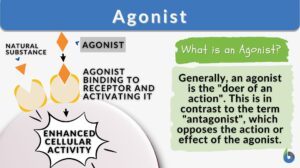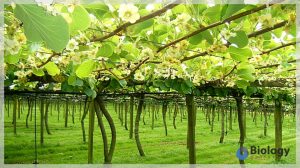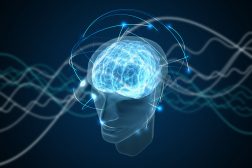
Agonist
n., plural: agonists
[ˈæɡənɪst)]
Definition: the primary doer of an action, such as a drug that binds with the receptor leading to an action or a physiological effect
Table of Contents
What is an Agonist?
In biology, an “agonist” is the “doer of an action”. Opposite of it is the antagonist, which opposes its action or its effect. The term “antagonist” is often used in kinesiology (“agonistic muscle”) and pharmacology (“agonistic drug”).
Agonists in kinesiology
First, let’s take “agonistic muscle” as an example of agonists in kinesiology (the study of muscle movement and function). In general, the “agonist” (agonistic muscle) is the muscle regarded as the primary doer of an action. There is another type of muscle that works the opposite of the agonistic muscle — the antagonist. An “antagonist” (antagonist muscle) is the muscle acting opposite or complementary to the primary doer.
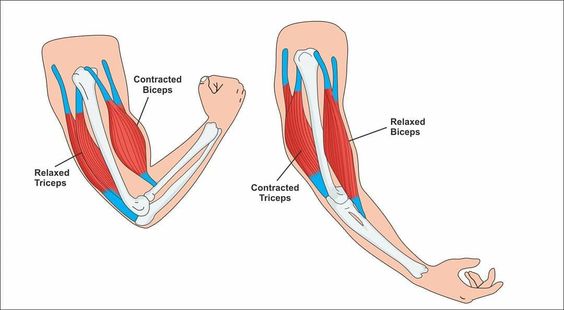
Watch this vid about the difference between agonist and antagonist muscles:
Agonists in Pharmacology
In pharmacology, an antagonist drug, or simply an agonist, is a substance that mimics the endogenous ligand and binds with the receptor to activate it and produce a similar biological response as that of the endogenous cellular ligand. Antagonists, on the contrary, are the ligands that bind to the receptor, however, a biological response is not produced.
Watch this vid about agonists and antagonist in pharmacology:
Agonist is a chemical substance that binds with a receptor and activates it to induce the action or response. Agonists have an intrinsic efficacy and affinity for the receptor that results in binding to it. This binding results in changes in the receptor’s functioning in the host cell.
In pharmacology, the agonist imitates endogenous cellular ligands (namely, hormones and neurotransmitters) by binding to the receptors and thus provoking a similar cellular response. Examples of agonist drugs are liraglutide and exenatide used in diabetes. These are glucagon-like peptide-1 receptor agonists (GLP-1 agonists) that help to maintain glycemic control or blood sugar levels.
What are ligands?
Ligands are the chemicals that bind to a receptor. Depending upon the changes in the receptor, which are induced by the binding of ligand to a receptor, a ligand can be:
1. Agonist – The substance that activates/provokes the receptor for biological action.
2. Antagonist – The substance that binds to the receptor, however, binding stops the desired response from the receptor.
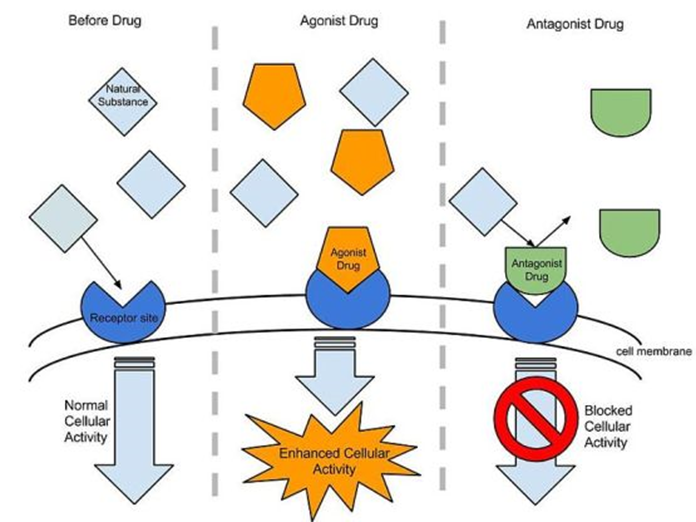
Agonist vs. Antagonist
Keeping the above discussion in mind, let us also understand the difference between agonist and antagonist.
Table 1: Agonists vs. Antagonists | |
|---|---|
| Agonists | Antagonists |
| Anything that provokes a response | Anything that inhibits the response |
| In literature, the agonist is the protagonist | In literature, the antagonist is the opposite of the protagonist or villain to a hero character |
| In molecular pharmacology, an agonist drug molecule will bind to the receptor to provoke a biological response similar to that of biological ligand-like neurotransmitters Example: Morphine, heroin, methadone, etc are opioid agonists. Epinephrine is an agonist of the G-protein-coupled receptor. | Pharmacologically, an antagonist drug molecule will bind to the receptor molecule and stop or inhibit its response Example: Naloxone and naltrexone are opioid antagonists |
| In muscles, the contraction of agonist muscle will produce the movement, e.g., biceps | Antagonist muscles relax when agonist muscle contracts to produce the movement, e.g., triceps |
| Biochemically, the binding of an agonist molecule will produce a physiological response | Biochemically, the binding of an antagonist molecule will inhibit the physiological response |
| An agonist molecule is characterized by receptor affinity and intrinsic efficacy | An antagonist molecule is characterized by receptor affinity but no intrinsic efficacy |
Data Source: Dr. Amita Joshi of Biology Online
Etymology
The word agonist is derived from the Greek word, “agōnistēs”, referring to a contestant, rival, or champion.
An agonist is the primary “doer of an action”. This is in contrast to the term “antagonist”, which opposes the action or effect of the agonist. It may pertain to a muscle, as in “agonistic muscle“, which contracts (while the antagonistic muscle relaxes) to produce muscle movement, such as when bending the elbow, the biceps are the agonist. An agonist may also refer to a chemical drug or substance, especially one acting like another substance as it is capable of binding to a receptor to elicit a response. An example is acetylcholine, being the agonist that combines with the cholinergic receptor. There are different kinds of agonists. Some of them are as follows:
- Full agonists have an affinity for and activate a receptor.
- Partial agonists bind and activate a receptor but have only partial efficacy at the receptor (compared with full agonists).
- Inverse agonists reverse the constitutive activity of receptors.
- Co-agonists work with other co-agonists to produce the desired effect together.
Etymology: from the Greek αγωνιστής (agōnistēs), meaning “contestant”, “champion”, “rival”
Compare: antagonist.
In the next sections, we will explore more about agonists in pharmacology. Let’s learn about the different types and mechanisms of action.
Types of Agonists
A receptor gets activated on binding with an agonist substance. Depending upon the origin, an agonist molecule can be:
Endogenous agonist
An agonist substance that is produced naturally by the body is referred to as an endogenous agonist. For example, for the acetylcholine receptor, acetylcholine is the endogenous agonist.
Exogenous agonist
Agonist substance that is not produced by the body and can be a foreign substance in terms of its origin. However, the exogenous substance has the ability to bind with a receptor to elicit a biological response. For example, pilocarpine is a drug, which is an exogenous agonist of the acetylcholine receptor.
Based on the biological response elicited by an agonist, an agonist can be classified as follows:
Full Agonists
The binding of a full agonist to the receptor results in provoking receptor response to the maximum. For example, opium, morphine, oxycodone, methadone, and heroin are full agonists of opioid receptors.
Partial Agonists (PA)
The PA acts on the same receptor as that of endogenous ligands, however, the biological response produced is submaximal, even when the agonist occupies the receptor to the maximum occupancy. Buprenorphine is a partial agonist drug that occupies the opioid receptor and is hence used to treat opioid dependency. Buprenorphine activates the opioid receptor but does not cause drug dependence and substance abuse. Other examples of partial agonist drugs include tramadol, pentazocine, and nalbuphine.
Inverse Agonists
Inverse agonists are substances that bind to the receptor to elicit a response that is opposite to that of agonists. Thus, they evoke an opposite pharmacological effect. Naltrexone and naloxone are two drugs that act as inverse agonists to the morphine-bound opioid receptor. Cetrizine is also an example of a selective inverse agonist to the H1 receptor.
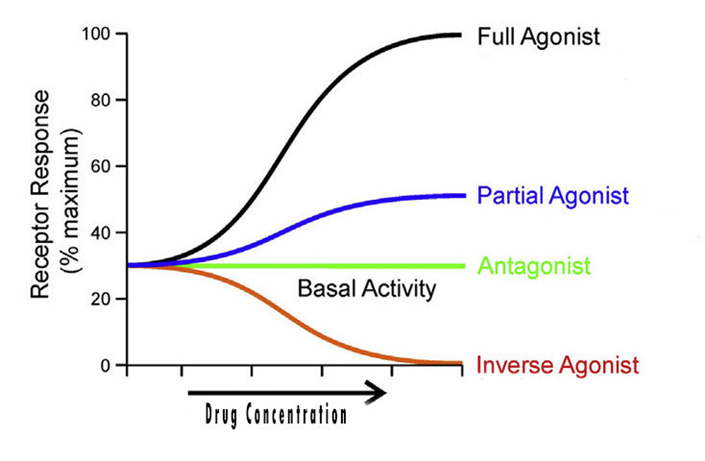
There are a few other agonists as well:
Co-agonists
When the binding of two or more agonists results in eliciting a response, such ligands are referred to as co-agonists. For example, D-serine, glycine, and glutamate are the three co-agonists required to activate the NMDA receptor. The binding of IFN-ɣ, TNF-α along with bacterial ligands results in the activation of macrophages to produce nitric oxide. A number of novel drugs are under research using this approach of experimental therapeutics of co-agonists.
Selective agonists
Such ligands bind specifically to a particular receptor type. For example, phenylephrine and oxymetazoline are selective α-1 receptor agonist, clonidine and methyldopa are selective α-2 receptor agonist, dobutamine binds to a specific receptor and is selective β-1 receptor agonist, salmeterol and albuterol are selective β-2 receptor agonist.
Superagonists
These are substances that produce maximum biological responses, more than biological endogenous ligands do. They are referred to as superagonists. For a simpler understanding, such ligands elicit more than 100% of biological response. For example, the superagonist for gonadotropin-releasing hormone is Goserelin.
Biased agonists
Ligands that have the capability to activate a specific subset of the receptor in the signaling cascade of the receptor. For the β-adrenergic receptor, Carvedilol is a biased agonist.
Mechanism of action
The biological effect of a ligand is defined by two intrinsic characteristics of a ligand:
Receptor affinity
This property defines the ability of a ligand to bind with the receptor. The receptor affinity of a ligand enables it to bind to the receptor. Both agonists, as well as antagonists, have receptor affinity.
Intrinsic efficacy
This property defines the biological changes brought in a receptor due to the binding of a ligand. Agonist substances have positive intrinsic efficacy as their binding to the receptor produces a biological response. While the antagonist substance has zero efficacy as it binds to the receptor due to affinity, however, binding does not produce any biological response.
Once an agonist has receptor affinity and intrinsic efficacy, it binds to the receptor molecule and results in inducing a number of conformational changes at the binding site of the receptor protein. These changes in the structure of receptor protein result in the activation of the receptor to produce a biological response.
Note it! How do inverse agonists work?
An inverse agonist is a relatively newly coined term, which refers to the substances that stabilize the constitutively active receptors and reduce the activity of such receptors. Inverse agonist has receptor affinity; however, they have a negative intrinsic efficacy.
To easily understand, constitutively active receptors are the receptors that have the ability to continuously modify conformationally.
Activity
The measure of the agonist activity can be expressed pharmacologically in two terms — potency, and therapeutic index.
Potency
It is referred to the amount of the agonist required to activate the receptor to elicit a biological response. The smaller the amount of agonist required, the higher the potency of the agonist. The requirement of a higher amount of agonist indicates a poor potency of the agonist.
The potency is measured in terms of EC50, which is the amount of agonist required to produce 50% of the response. It is inversely proportional to the potency. EC50 values give a good indication of the comparative efficacy of different agonists (Figure 4).
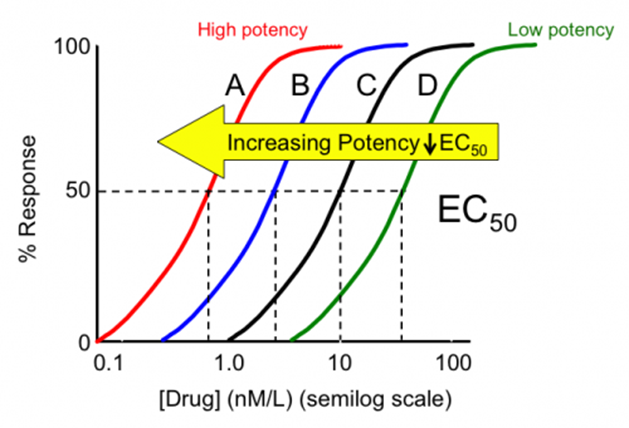
Therapeutic index
The therapeutic index of a drug molecule is the ‘window’ within which it exhibits a therapeutic effect. Above this window, the drug molecule exhibit toxicity while below the therapeutic window, it is sub-therapeutic and does not show any clinical effect. The dose that results in toxicity in 50% of the population is represented by TD50.
Therapeutic index= TD50 / EC50
A drug with a narrow therapeutic index (i.e., smaller therapeutic window) has a higher probability of exhibiting side effects (e.g., warfarin, digoxin, phenytoin, amphotericin, 5-Fluro-uracil, etc). Conversely, the drug with a broad therapeutic index (i.e., large therapeutic window) has a low probability of exhibiting drug side effects. Thus, this therapeutic window shows the margin of safety of a drug molecule (Figure 5).

Take the Agonist – Biology Quiz!
References
- Berg, K. A., & Clarke, W. P. (2018). Making Sense of Pharmacology: Inverse Agonism and Functional Selectivity. The international journal of neuropsychopharmacology, 21(10), 962–977. https://doi.org/10.1093/ijnp/pyy071
- Strange P. G. (2008). Agonist binding, agonist affinity and agonist efficacy at G protein-coupled receptors. British journal of pharmacology, 153(7), 1353–1363. https://doi.org/10.1038/sj.bjp.0707672
- Strange P. G. (2008). Agonist binding, agonist affinity and agonist efficacy at G protein-coupled receptors. British journal of pharmacology, 153(7), 1353–1363. https://doi.org/10.1038/sj.bjp.0707672
- Zamolodchikova, T. S., Tolpygo, S. M., & Kotov, A. V. (2021). From Agonist to Antagonist: Modulation of the Physiological Action of Angiotensins by Protein
- Conjugation-Hemodynamics and Behavior. Frontiers in pharmacology, 12, 772217. https://doi.org/10.3389/fphar.2021.772217
©BiologyOnline.com. Content provided and moderated by Biology Online Editors.

